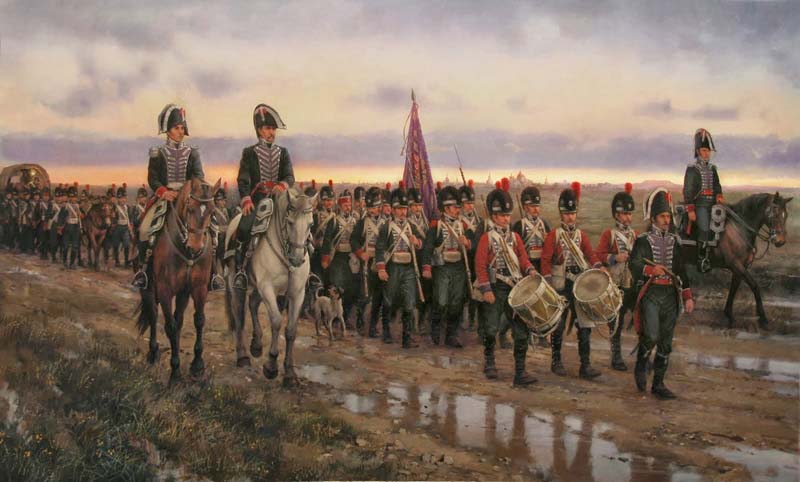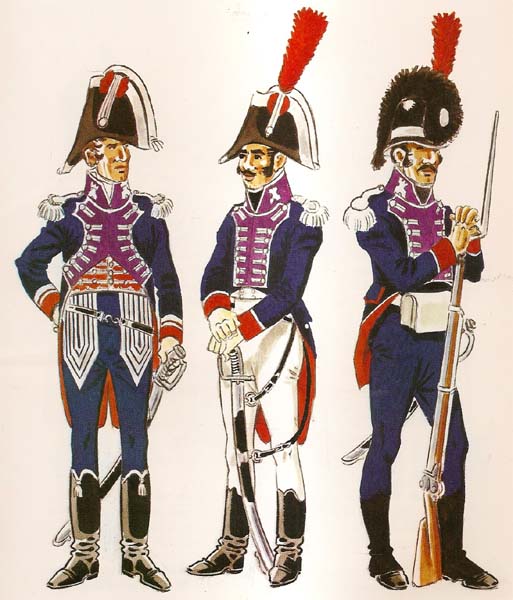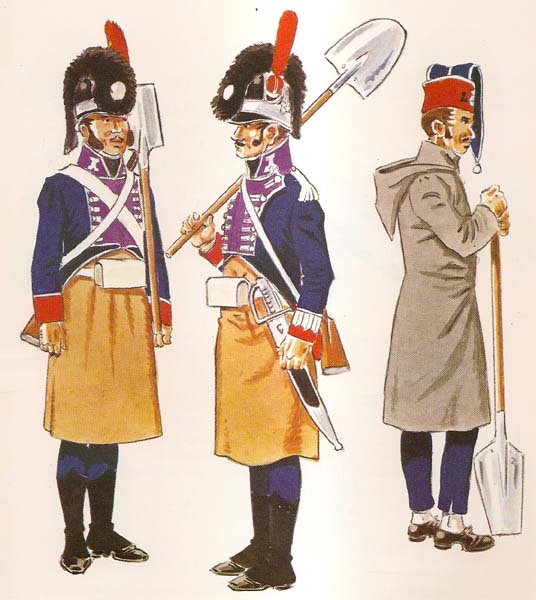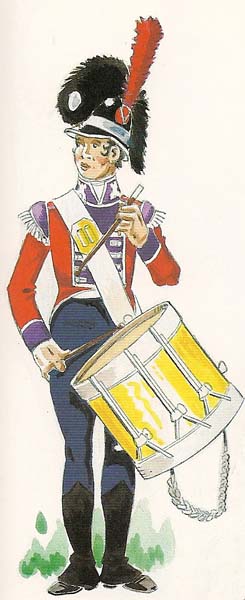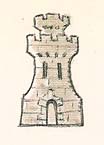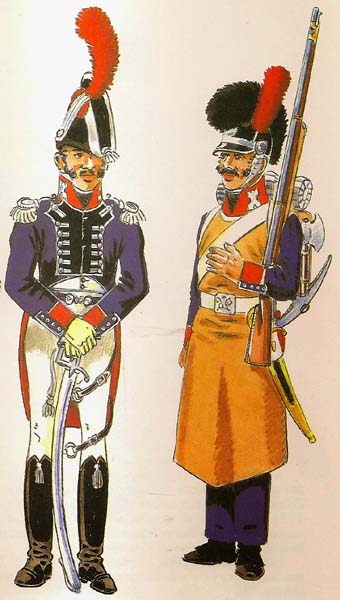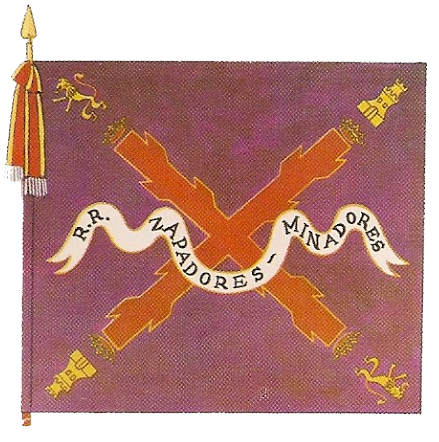|
Spanish Royal Regiment of Sapper-Miners
OrganisationThe RegimentBy Royal Decree of 6th August 1801, the Royal Sapper Corps (Real Cuerpo de Zapadores) was created. By Royal Decree of 5th September 1802, this was reorganised as the Royal Regiment of Sapper and Miners (Regimiento Real de Zapadores y Miradores) which was formed and based in Alcalá de Henares near Madrid. The regiment consisted two battalions. Some sources suggest that the regiment even had a staff. Each battalion had a staff and five companies; four of sappers and one of miners. The regiment's officers were drawn from the Royal Engineer Corps (Real Cuerpo de Ingenieros). The staff of each battalion had a establishment of 11 consisting of:
1 Colonel - 1st battalion only Each sapper or miner company had a establishment of 132 consisting of:
1 Captain In Spain, at the start of the war in 1808 the regiment had 922 NCO's and men and 41 engineer officers (1 Colonel, 1 Lieutenant Colonel, 1 Major, 10 Captains 2 Second Captains, 14 Lieutenants and 12 Ensigns). It also had men serving in Denmark and Portugal. Romana's Expeditionary ForceIn 1807 a new Sapper company was formed to serve with Marqués de la Romana's Expeditionary Force in the North (la División Expedicionaria del Norte). It consisted of 119 (some sources say 127) NCO's and men drawn from all companies of the existing regiment. The Expeditionary Force included 13 officers from the Royal Engineers, of which 5 served with the Sappers and the remainder on the staff. The company was evacuated from Denmark by the (British) Royal Navy in August 1808 and returned to Spain were they joined the Army of the Left in time to participate in the Battle of Espinosa de los Monteros on 10th November 1808. Junot's Army of PortugalTwo companies of sappers were formed to serve with Junot's Army of Portugal in the Division Carrafa and the Division Taranco. Like Romana's Division, they were drawn from all companies of the existing regiment and totalled 501 NCO's and men and 18 engineer officers. After the outbreak of hostilities and the withdrawal of Portugal, they joined the armies of Galicia and Andalusia. UniformsAccording to the Royal Decree of 1802, the uniform of the Sappers and Miners should be the same colours as that of the Engineer Officers, but the coat is short, buttonholes on the lapels of white thread, and turrets on the collar either embroidered or white metal, as deemed appropriate. 1805 Uniform
Sappers and MinersThe 1805 uniform was a dark blue short-tailed coat. The collar and lapels were purple, the cuffs and turnbacks were red and the piping white. On the collar were two white turret badges. Buttons were white metal and buttonholes had white lace. The waistcoat was white (or possibly red) and breeches were blue worn with short black gaiters. White breeches may have been worn in the summer. Headgear was a strong black leather helmet, with bearskin crest, white turban and red plume and the red Spanish cockade. It had an oval badge of white metal on its front (probably the royal coat of arms surrounded by the text “Real cuerpo de Zapadores y Miradores”). They were issued with a red forage cap with blue bag and white piping, on the front was a badge with the royal coat of arms surrounded by the text “Real cuerpo de Zapadores y Miradores” (Royal Corps Sappers and Miners) beside which the number of the company and the battalion embroidered in black. Engineer OfficersThe 1805 uniform was a dark blue long-tailed coat. The collar and lapels were purple, the cuffs and turnbacks were red and the piping white. On the collar were two silver turret badges. Buttons were silver and the seven buttonholes on each side of the lapels had silver lace. The buttonhole lace was rather small, and yet, in several portraits of the time, the buttonholes were formed by wide lace, transversely lengthened to join in the middle of the lapels (One senior officer in the "Exploit of the Sappers" painting is wearing such lace). The waistcoat was red with white piping. Breeches were blue worn with "Hessian-style" half boots. Two different contemporary illustrations show blue breeches with silver hussar-style lace, so while this was not regulation, neither does it seem to be just one officer's fancy. White waistcoat and breeches could be worn in the summer. Headgear was a black felt bicorne, with silver lace, adorned with the red Spanish cockade and a red plume. Officers were armed with a sabre in a silver scabbard rather than a straight sword. On campaign they carried a pistol at the waist. Officers horses should have schabraques and holster covers in blue, edged with silver lace. DrummersDrummers and probably fifes wore the same uniform as the soldiers except for the coat colour. The coat was red. The collar and lapels were purple and the piping white. The colour of the cuffs and turnbacks is uncertain, they were either purple or blue. Purple wings were worn on the coat. The drum was brass and the hoops were painted white. It was carried on a white leather belt and probably worn with a white apron. 1813 UniformIn 1813 the uniform underwent some changes, the lapels were now black (velvet for Engineer Officers) and the collar and cuffs red. The white piping was removed, at least from the collar and turnbacks. By reducing the number of colours, the cost of the uniforms was also reduced. Purple and white were colours which easily sullied and the removal of these reduced the time spent on the upkeep of the uniforms. Trousers had replaced breeches.
DistinctionsRank Distinctions for Officers and NCOs were the same as for the rest of the army and are documented here. Sergeants epaulettes are traditionally in the facing colour, however the sappers and miners appear to have used white, but some non-contemporary illustrations show purple or red. Corporals were distinguished by two white lace stripes around the jacket cuffs. Lance Corporals were distinguished by one white lace stripe around the jacket cuffs. Sappers and Miners 1st Class had small white "epaulettes" (dragonas) while Sappers and Miners 2nd Class had blue shoulder straps. Miners are distinguished from sappers by the three white laces on the cuffs. It was required that all sergeants, corporals, drummers, fifes and soldiers had mustaches. EquipmentSappers and miners were armed with short muskets and long bayonets. A white ventral (belly) cartridge pouch was worn. They carried a machete which was a more robust model than the short sword carried in the infantry by grenadiers and sergeants. In addition to the musket and bayonet, the sergeants and corporals were to be armed with the same short sword carried by grenadiers and sergeants in the infantry (rather than the machete) and a pistol at the waist. They wore a tan supple leather apron of the same model used by the infantry pioneers (Gastadores). They carried tools for digging, usually shovels but even pick-axes are shown. They were issued a grey hooded greatcoat and a backpack in goatskin or calfskin. Belts were of white leather. FlagsThe Royal Decree of 1802 set the number of flags to one per infantry battalion. From that time on, the 1st battalion should carry the Coronela and other battalions the Sencilla. Thus when formed, the 1st battalion of Sapper and Miners carried a Coronela and the 2nd battalion carried a Sencilla. Operating as they did in seperate companies, the flags of the Sappers and Miners were not normally seen on battlefields. Below is the obverse of the Sencilla of the 2nd battalion of Sapper and Miners. It was of purple cloth with the red Cross of Burgundy. It had a ribbon with the text "R. R. ZAPADORES-MINADORES" and alternating castles and lions in the four corners This flag is based on a colour photo reproduced in the "Historical Study of the Corps of Engineers" (Estudio Histórico del Cuerpo de Ingenieros). This flag is said to have been carried at Bailén.
The Coronela was also of purple cloth with the Royal Coat of Arms replacing the Cross of Burgundy. It had a ribbon and alternating castles and lions in the four corners like that showm on the Sencilla. The obverse (or front, when the stave is to the left) had the royal coat of arms shown normally while the reverse (or rear, when the stave is to the right) had the royal coat of arms reversed. These agree with the descriptions given in the Royal Decree of 1802, except that there it says the text should be "Real Cuerpo de Zapadores y Minadores". Sources
|


